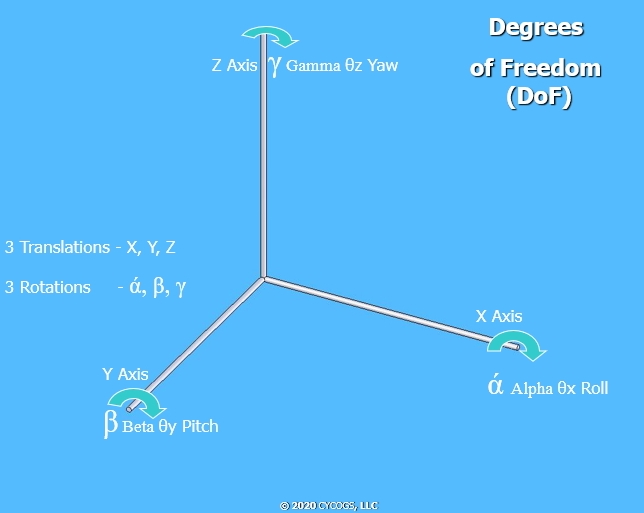Degrees of Freedom description
The
This is a description of the term “Degrees of Freedom” (DoF) as applied to robotics.
How do we keep track of a robot’s position in the physical, task, or work space?
In robotics, the term “Degrees of Freedom” (DoF) represents the set of independent translations and rotations that specify the displaced position of the rigid robot part, body or system (its coordinates in three-dimensional space). A simple robot or other rigid body would have at most six DoF. These include three axis rotations and three translations. Translation is the ability to move on an axis without rotating, while Rotation is the revolving about an axis without any translations.
 X axis rotation is named the roll axis and is represented by ά alpha, or theta-x θx.
X axis rotation is named the roll axis and is represented by ά alpha, or theta-x θx.X Axis translation forward / back, is also called, surge.
Y axis rotation is named the pitch axis (Tilt) axis and is represented by β beta or theta-y θy.
Y Axis translation is left / right, is also called, sway.
Z axis rotation is named the yaw axis (pan) and is represented by γ gamma or theta-z θz.
Z axis translation up / down, is also called, heave.
Examining a one - dimensional work space only allows for one DoF.
A two - dimensional workspace allows three DoF; and a three dimensional workspace allows for six DoF. A robot or robot part like an arm or leg with several movable parts or segments would have the combined DoF summed from the individual DoF of the parts or segments, minus any internal constraints occurring when in motion.Holonomicity refers to robotics sum of its Degrees of Freedom and the relationship to the controllable Degrees of Freedom.
A robot that controls all of its work space Degrees of Freedom (DoF) is said to be Holonomic. A robot or robotic part with fewer controllable DoF than total workspace DoF is said to be non-holonomic, and a robot with more controllable DoF than total workspace DoF is said to be redundant. The term Holonomic is usually applied to robotic arms. Holonomic Redundancy usually has more DoF controllable motions than DoF available in its task or work space. For example, a train can only move on the X axis work space, one DoF (the train tracks), and can control its position on that one axis,
thus it is holonomic.
Most automobiles can be orientated and move to any position in two - Dimensional (2D) work space.
The automobile requires three DoF to describe its position (X, Y and gamma), but at any point, it can move only along the vehicles centerline
and turn with a steering angle input.
(ignoring skidding or “drifting”) Thus, it has only two control DoF and three positional DoF; so, the automobile is non-holonomic.
For example, a train can only move on the X axis work space, one DoF (the train tracks), and can control its position on that one axis,
thus it is holonomic.
Most automobiles can be orientated and move to any position in two - Dimensional (2D) work space.
The automobile requires three DoF to describe its position (X, Y and gamma), but at any point, it can move only along the vehicles centerline
and turn with a steering angle input.
(ignoring skidding or “drifting”) Thus, it has only two control DoF and three positional DoF; so, the automobile is non-holonomic.

The DoF term can be used to describe a particular movement, as well as a unique representation of movement possibilities.
When used by actuators for position and manipulator configuration, DoF control definitions can use forward and inverse kinematic relationships for movement computations.Movements are calculated using mathematics, ranging from a simple one-X axis Algebraic move from point A to point B, such as Xb – Xa = move distance, to a vector Quaternion positional rotation in three dimensions using Linear Algebra matrix theory.
Learn more about AI Robotics with the
Contact: Send questions and comments about the Degrees of Freedom Education by